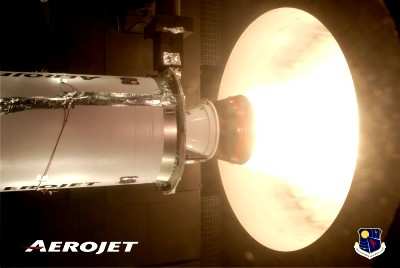Fri, Oct 09, 2009
Aerojet Developing New ICBM Motors Through An Air Force
Contract
 Aerojet and the U.S. Air Force successfully conducted a
full-scale, full-duration static test of Aerojet's Advanced Second
Stage (A2S) motor, reporting that all test objectives were fully
achieved.
Aerojet and the U.S. Air Force successfully conducted a
full-scale, full-duration static test of Aerojet's Advanced Second
Stage (A2S) motor, reporting that all test objectives were fully
achieved.
Aerojet developed the large solid propellant rocket motor on the
Propulsion Application Program (PAP) under contract to the 526th
ICBM Systems Group at Hill AFB, Utah. The test was conducted at
simulated altitude conditions, essentially zero atmospheric
pressure, by the Air Force's Arnold Engineering Development Center
in Tullahoma, PA. The purpose was to measure true motor performance
in a flight-like environment. This was the second successful static
test of the A2S motor following a flawless sea-level test at the
Air Force Research Laboratory at Edwards AFB in California in
June.
The PAP program's primary goal is to develop a new generation of
ICBM-sized motors with increased propulsion performance and lower
manufacturing and operational costs. In order to meet these goals,
the A2S design consists of numerous new technologies and
manufacturing materials and processes including a graphite
composite case fabricated with environmentally friendly materials,
a low-cost movable nozzle capable of six degrees of thrust vector
control, Honeywell-supplied electrical-mechanical actuators and
digital controller, and high energy solid propellant developed at
Aerojet's Sacramento, CA facility.
Initial post-test inspection indicates that the motor
performance was excellent and the component design was robust. This
is the final static test of the A2S motor under the PAP program as
the design has been validated under both sea-level and altitude
conditions.

The successful test culminates a multi-year effort that applies
technology pertinent to the sustainment of strategic strike missile
architecture," said Mark Kaufman, executive director of Strategic
Propulsion Programs at Aerojet. "The Propulsion Applications
Program has proven to be a worthwhile initiative for balancing
design, technology and methods of manufacture with overall weapon
system life cycle cost. The A2S can now be added to the Air Force
portfolio of ICBM propulsion options as they weigh alternatives for
the sustainment of strategic strike. The A2S program also provided
an excellent venue for engaging a new generation of propulsion
engineers."
More News
A Puff Of Smoke Came Out From The Top Of The Engine Cowling Followed By A Total Loss Of Engine Power On May 9, 2025, about 1020 mountain daylight time, an experimental amateur-buil>[...]
From 2022 (YouTube Edition): Jenny, I’ve Got Your Number... Among the magnificent antique aircraft on display at EAA’s AirVenture 2022 was a 1918 Curtiss Jenny painstak>[...]
Very High Frequency (VHF) The frequency band between 30 and 300 MHz. Portions of this band, 108 to 118 MHz, are used for certain NAVAIDs; 118 to 136 MHz are used for civil air/grou>[...]
“From approximately November 2021 through January 2022, Britton-Harr, acting on behalf of AeroVanti, entered into lease-purchase agreements for five Piaggio-manufactured airc>[...]
Microburst A small downburst with outbursts of damaging winds extending 2.5 miles or less. In spite of its small horizontal scale, an intense microburst could induce wind speeds as>[...]
 NTSB Prelim: Lee Aviation LLC JA30 SuperStol
NTSB Prelim: Lee Aviation LLC JA30 SuperStol Classic Aero-TV: Curtiss Jenny Build Wows AirVenture Crowds
Classic Aero-TV: Curtiss Jenny Build Wows AirVenture Crowds ANN's Daily Aero-Term (05.30.25): Very High Frequency (VHF)
ANN's Daily Aero-Term (05.30.25): Very High Frequency (VHF) Aero-News: Quote of the Day (05.30.25)
Aero-News: Quote of the Day (05.30.25) ANN's Daily Aero-Term (05.31.25): Microburst
ANN's Daily Aero-Term (05.31.25): Microburst



